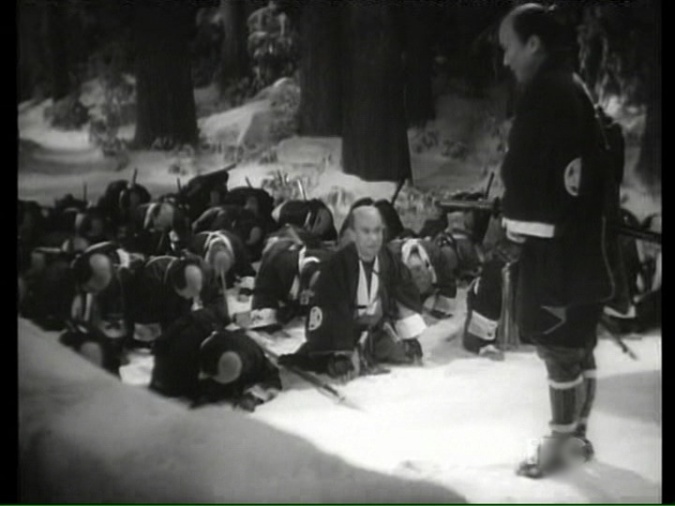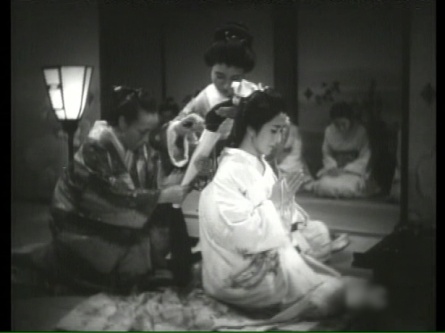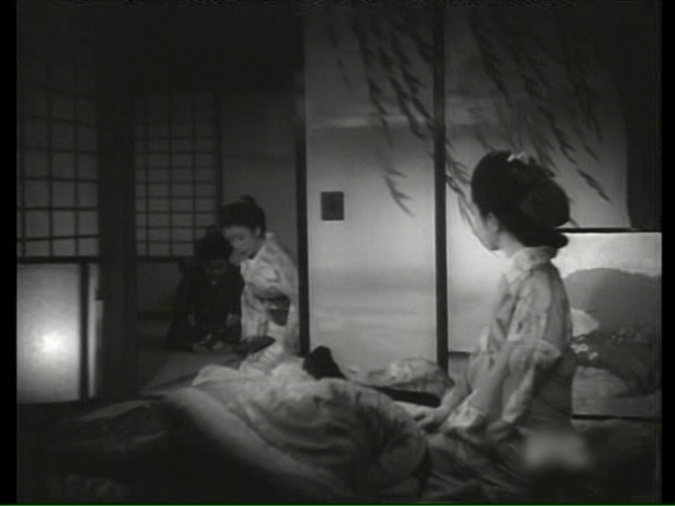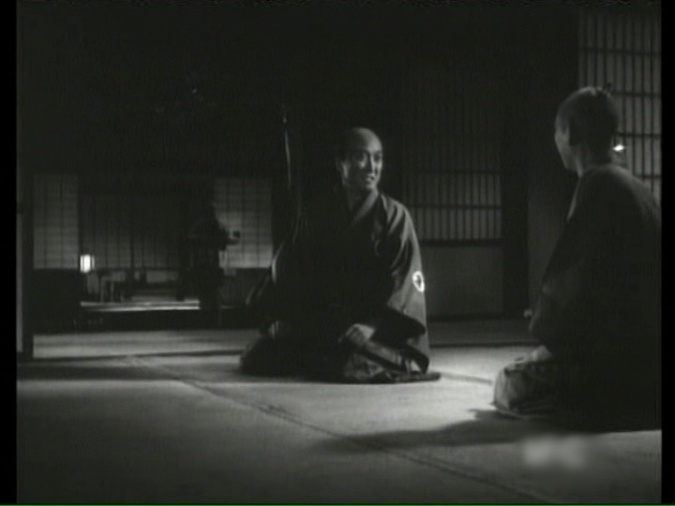
The ronin congratulate themselves on their successful revenge
The Chushingura story is one of the basic cultural signposts of traditional Japanese culture. As such, it has been filmed numerous times, the latest in 2010 with Koji Yakusho continuing his traverse of all the classic roles in Japanese films. (The less mention of the Keanu Reaves monster movie version the better.) It is so familiar to followers of Japanese film that I don’t think I need to even do a plot summary.
When I first saw Mizoguchi’s version on VHS, it was like having to read Clarissa, one of those works the professors all said was great and important but in practice is in real prop-the-eyelids-open territory. Fortunately there is a Criterion edition that you can watch in HD on a large screen. It’s still boring, but more like reading Racine than Richardson.
Actually, the Racine comparison is somewhat more than just an attempt at a joke. Like Racine, Mizoguchi moves almost everything of interest off-stage, leaving us to see and hear only reports and discussions about the action. And, like Racine, it is expressed with a beautiful linguistic purity, though in this case the language is the camera.
There are not many movies about which you can say that every frame is a work of art, but this is surely one of them. It is almost certainly the purest statement of classical Japanese visual aesthetic in the 4:3 format, a Noh drama without the masks or dancing.
Mizoguchi manages this while continuing to use his famous moving camera, aided by sterling photography and lighting by Kohei Sugiyama and art direction surprisingly credited to Kaneto Shindo, who later became one of the great writer/directors of world cinema. This all combines for a remarkably unified whole. The camera crawls around and through the rooms of the castles and houses but not like it is prowling or overhearing but rather somehow shaping the action, so that a film composed mostly of dialogue seems constantly in motion without any cutting tricks or exaggerated close-ups.
But the visual formalism coupled with Mizoguchi’s long-standing practice of keeping his characters in the middle ground or even farther from the camera utterly destroys any emotional connection with those characters. Most scenes are composed in layers, often three deep as in the samples above, and usually the most significant part of the scene is in the third, farthest, layer. In the VHS version, you could not even identify many of the characters, they were placed so far from the camera. At least in the DVD/streaming version, that problem has been remedied — the detail of the photography is sufficiently clear that you can usually tell not only what is happening but also who is talking, but only if you watch on a large screen. Do not try to screen this on your tablet or laptop.
Perhaps this is intended to make the story less personal and more representative of a code and a way of life, with the characters standing in as living symbols rather than as people. If so, it works all too well. There is one really effective scene: when Lord Asano commits hara-kiri, Mizoguchi stays instead with his wife, who silently has her hair cut, and the action is remarkably moving.

Lady Asano cuts her hair
But beyond that, there is very little real connection with the situation. Oishi, for example, has only one scene in which he drinks, which is hardly a “descent into depravity & pleasure,” and unlikely to throw any spies off his scent.
Whatever tension may have been developed in Part I is completely dissipated in Part II. It begins with a long scene at the Shogunate relating events from before Part I ended, then a repeat of the last scene of Part I in toto, so that we’re half an hour or so in before the decision to seek revenge is put in action. Lady Asano simply receives a letter that the ronin have been successful. After a brief scene at the Lord’s grave, we spend the last hour or so as the men await the final judgment, most spent focused on a woman disguised as a boy trying to see her fiance to see if he really loved her before he ran off with the other ronin. Then, of course, the final deaths happen off-screen.
Mizoguchi remains a critics’ darling and I don’t think there is any film-maker in the world who had a trifecta of almost perfect works of art back to back like Ugetsu, Crucified Lovers, and Sansho the Bailiff,* not even Bergman, Fellini, or Kurosawa. But, for me at least, most of his movies are simply exercises in style or female humiliation or both, with every hint of drama drained from them by the very style that fascinates other critics. In many ways, Genroku chushingura is the very peak of that style, made as it was before the austerity of the Occupation era and with additional budget supplied by the government itself for a patriotic story so that Mizoguchi could take even more time than usual making every shot perfect.
- * Most western critics add a fourth to that, The Life of Oharu, which I think is the perfect illustration of Mizoguchi placing style over content and thus do not rank with the other three.






Pingback: The Loyal 47 Ronin / Chusingura (1958) | Japanonfilm
Yup, this one was a snoozer. Watched it and also watched the 1962 version and the latter is much better. Not showing the raid on Lord Kira’s compound was just perverse.
LikeLike
Pingback: Ugetsu monogatari (1953) | Japanonfilm
I saw this movie in a theater in Honolulu when I was in college at UH-Manoa in the 1970’s. My friends and I were only interested in seeing sword fight movies at the time. To add to what Vidor said in his comments, we waited, watching the film for what seemed to take the full two years in order to see the big attack at Kira’s compound. As the tension rose while the 47 brave samurai marched in the snow to the mansion we were finally going to be rewarded for our long, long wait. The scene then cut to the maid telling Lord Asano’s widow that the vendetta had been carried out. Our disappointment was beyond description!
LikeLike
Pingback: Musashi Miyamoto (1944) | Japanonfilm
Pingback: Actress / Eiga joyu (1987) | Japanonfilm
Pingback: Who’s Camus Anyway? / Kamyu nante shiranai (2006) | Japanonfilm
Pingback: Japan’s War movies (I) | Japanonfilm
Pingback: Story of a Beloved Wife (1951) | Japanonfilm